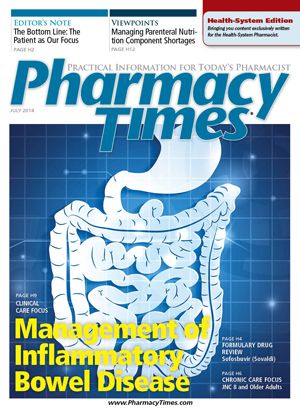Publication
Article
Pharmacy Practice in Focus: Health Systems
Strategies for Managing Parenteral Nutrition Component Shortages
Author(s):
Background
Shortages of parenteral nutrition (PN) components are not new to health care professionals who provide nutrition support therapy. Clinicians have been managing shortages since the intravenous (IV) adult multivitamins shortage in 1988 and the subsequent shortages of both adult and pediatric multivitamins. These shortages were intermittent and usually short-lived. However, since 2010, almost every component used in the compounding of PN admixtures has been in short supply (Table 1).
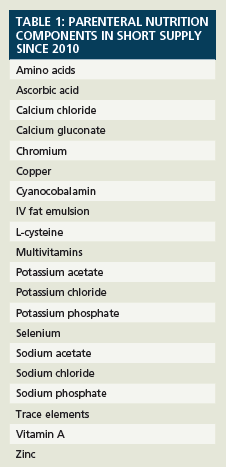
A number of factors have contributed to the shortages of sterile injectable drugs, including many of the PN components.
Sterile injectable drugs are produced by only a few manufacturers. Some manufacturers have shut down and others have had quality issues requiring remediation. When one company cannot produce, it increases demand on another company, which cannot keep up. In some situations there is only 1 source for the active pharmaceutical ingredient. In 2013, 65% of sterile injectable drug shortages were the result of manufacturing issues and almost one-quarter were due to discontinuation of products (Online Figure 1). The reasons for shortages are similar to those in 2010; however, 54% of shortages were due to quality issues and only 11% were the result of discontinuations.
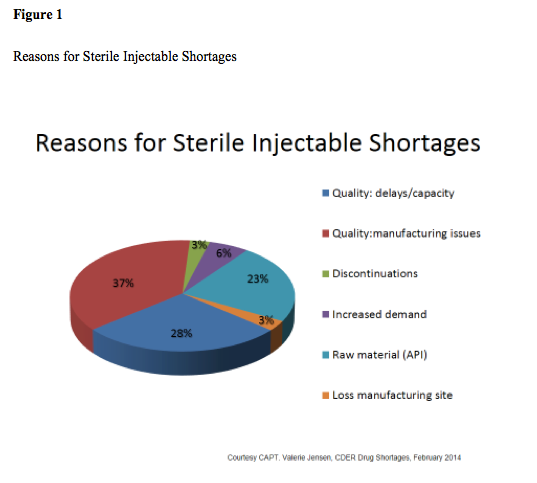
The number of new drug shortages peaked in 2011 at 251 and has since declined each year, with only 44 new shortages in 2013. Of these, 80% are sterile injectables (Online Figure 2). The decrease in shortages is in part due to the 2012 FDA Safety and Innovation Act, which requires manufacturers to notify the FDA of impending shortages and discontinuation. The FDA also has worked with manufacturers to prevent shortages and restore production. Although the number of new shortages of sterile injectables has declined, many shortages, including some PN component shortages, are ongoing with no resolution in sight.
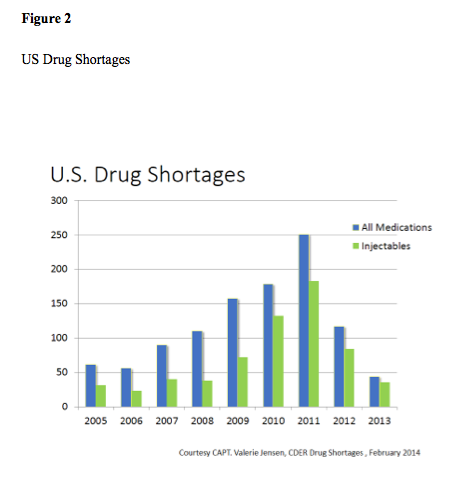
Impact of PN Shortages on Patient Care
Shortages of PN components compromise patient care, especially for the most vulnerable patients, including neonates and those with malabsorption syndromes requiring long-term therapy. For these patients there are limited options for alternative therapies.1 Parenteral nutrition shortages and the limited choices of alternative of therapy have forced some institutions to delay treatment, modify doses or regimens, postpone surgeries, and transfer patients to other facilities.2
Errors and patient harm have been associated with shortages of PN components. Deaths and lactic acidosis due to thiamine deficiency have been reported during shortages of multivitamins.3,4 Thiamine is critical and should be administered daily to patients requiring PN, especially those on long-term PN. Zinc deficiency dermatitis in cholestatic extremely premature infants was related to the shortage of injectable zinc.5
Patient safety can be compromised at any point in the PN process. The steps of the PN process include procurement, management, prescribing, order review, compounding and dispensing, administration, monitoring, and patient outcomes. 1 In 2011, the American Society for Parenteral and Enteral Nutrition (A.S.P.E.N.) surveyed clinicians regarding the types of shortages they were experiencing, medication errors associated with shortages, and any adverse event related to the shortages. Respondents reported fluid, electrolyte, and acid-base disturbances associated with shortages of the electrolyte and mineral components or using alternative products. Deficiencies of vitamins and trace element were also reported.1
In a recent survey, 16.4% of respondents reported that patient outcome was directly affected by the PN component shortages, including nutrient deficits, increased length of stay, and increased morbidity and mortality.6 In 2012, the Institute for Safe Medication Practices (ISMP) conducted a survey of clinicians to assess medication errors or suboptimal patient outcomes associated with shortages of PN components. (See Online Table 2 for the PN components more frequently associated with errors.) Other errors reported by respondents included calculation errors, compounding errors, as well as electrolyte abnormalities and nutrient deficiencies.7
Table 2
Errors and Preventable Adverse Drug Affects Associated with Parenteral Nutrition Component Shortages
PN Component
Examples of Errors or Preventable Adverse Drug Affects
Trace elements
Allocations for adding to PN on certain days led to omissions when schedule not followed
Added the usual volume (1 mL) but the alternative product
Sodium phosphate
Patient unable to tolerate oral alternative; developed severe hypophosphatemia
Infants with hypophosphatemia developed bone fractures
Hyperkalemia in patients given the potassium phosphate alternative
Calculation errors when substituting potassium phosphate for sodium phosphate
Potassium phosphate
Hypernatremia in patients given the sodium phosphate alternative
Infants with hypophosphatemia developed bone fractures
Potassium acetate
PN prepared incorrectly when 4 mEq/mL alternative placed on compounder instead of 2 mEq/mL product.
Multivitamins
Vitamin deficiencies in adults when vitamins not provided daily
Adult and pediatric multivitamin products mixed up
PN = parenteral nutrition
Adapted from ISMP. Survey links PN component shortages to adverse outcomes. Medication Safety Alert! February 13, 2014
Strategies for Managing Shortages of PN Components
Providing PN therapy during product shortages requires preparation, planning, vigilance, and continuous assessment of the entire PN process to optimize patient care quality and avoid patient harm.
The first step is to be prepared for shortages and outages. Shortages of these products and other sterile injectables occur more frequently than in the past and may be prolonged for months or even years. Health care organizations should identify key personnel and processes for managing shortages. Key personnel are responsible for keeping up-to-date on shortages or impending shortages, monitoring inventory, and identifying alternative products. Processes should be in place to communicate PN component shortages and outages to prescribers and staff who participate in providing PN therapy. Furthermore, protocols for PN component substitution and/or conservation strategies should be developed and approved. Processes should be in place to communicate to prescribers and staff the substitution and/or conservation strategies and when the protocols are implemented.8,9
When a shortage of a PN component occurs, key personnel should learn more about the shortage, including the manufacturer, and the anticipated duration of the shortage and any allocation procedures. Inventory of the PN component should be assessed. Protocols for conserving the PN component should be implemented. Potential alternatives for the PN component in short supply should be identified.9
A.S.P.E.N. has developed and published Parenteral Nutrition Product Shortage Considerations to aid clinicians in managing PN component shortages. The recommendations include conservation and allocation strategies, methods to minimize waste, alternative PN components, and methods to safety issues. These shortage considerations are listed in Table 3 and can be accessed via the A.S.P.E.N. Drug Shortage Web page (www.nutritioncare. org/Professional_Resources/Drug_ Shortages_Update). There are several conservation and safety strategies that are common to managing shortages of any PN component. These are outlined in Online Table 4.
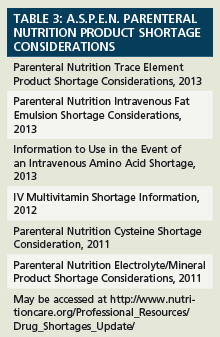
Table 4
Parenteral Nutrition Product Shortage General Strategies
• Implement conservation strategies early
• Assess the indication for PN
• Switch to oral or enteral nutrients (excluding patients with malabsorption syndromes)
• Reserve intravenous products for those receiving PN or those with a therapeutic medical need for intravenous nutrients
• Reserve supply for those vulnerable populations—neonates, pediatrics, or malabsorption syndromes
• Reserve age-specific products for designated patient populations
• Observe for deficiencies with the ongoing shortages. Increase awareness and assessment for signs and symptoms of deficiencies
• Review the entire product portfolio—other sizes, concentrations, etc may be available
• Purchase only as much product as needed; no hoarding, stockpiling
• Compound PN in a single, central location (either in a centralized pharmacy or as outsourced preparation) to decrease inventory waste. Consider a supply outreach to other facilities
• Observe and be compliant with the product labeling, USP <797>, and state boards of pharmacy rules and regulations
• Be cognizant of the safety concerns and develop and implement policies and procedures to avoid errors
• Report patient problems related to shortages to ISMP Medication Errors Reporting Program (MERP) (www.ismp.org/merp)
• Report experiences with PN product shortages to ASPEN. Provide specific information but do not include patient identifiers. Send to [email protected]
Outages of US commercially available PN components may prompt health care organizations to procure these products from a compounding pharmacy. Processes should be in place to evaluate the compounding pharmacy for compliance with USP General Chapter <797>, federal laws and regulations, and state boards of pharmacy rules and regulations. 9
During prolonged shortages of a PN component, the FDA may approve the temporary importation of alternative products to help. These products may have different profiles, ratios (doses), packaging, and labeling than US products and thus warrant careful evaluation before use. Currently, several imported products are available for compounding PN admixtures. They are sodium glycerophosphate, adult and pediatric multicomponent trace elements, and zinc gluconate trihydrate. More information on these products is available from the manufacturer/distributor or the A.S.P.E.N. Drug Shortages Web page (www.nutritioncare. org/Professional_Resources/Drug_ Shortages_Update).
Managing shortages of PN components does not stop with implementing conservation/allocation strategies or selecting an alternative product. There should be a procedure to modify the PN order template (electronic or paper) to reflect conservation strategies, outage of a component, and/or the use of an alternative product. These changes must occur in a timely manner. Processes should also be in place to change the PN label to reflect any changes in the PN order due to outages or conservation strategies. Lastly, the automated compounding device software should be modified to reflect changes in PN components due to conservation/allocation strategies or the use of an alternative product. This includes determining compatibility of all PN ingredients and changing the National Drug Codes (NDC) numbers, which are critical for barcoding systems to function correctly.9 Of note, compatibility information on imported PN components may be limited and these products do not have NDC numbers.
Quality improvement programs should be in place to track and analyze errors associated with PN component shortages and outages.9 In addition to errors associated with prescribing, calculations, compounding, and administering PN, clinicians should also track and report suboptimal patient outcomes related to shortages and outages of PN components. There should be a heightened awareness of nutrient deficiencies and assessment for signs and symptoms associated with deficiencies. Adverse events associated with shortages should be reported to ISMP Medication Errors Reporting Program (MERP) (www .ismp.org/merp). Additionally, report experiences with PN product shortages to A.S.P.E.N. ([email protected]). Provide specific information, but do not include patient identifiers.
Summary
The shortages of PN components continue to challenge clinicians and patients requiring this therapy. For neonates and those requiring long-term PN, this therapy is life-saving and there are limited alternatives. PN component shortages have been associated with patient harm including death due to nutrient deficiencies. Processes to safely manage shortages should be in place for each step of the PN process. Providing PN therapy during product shortages requires vigilance and continuous assessment of the entire PN process to optimize patient care quality and avoid patient harm.
Beverly Holcombe, PharmD, BCNSP, FASHP, is a clinical practice specialist at the American Society for Parenteral and Enteral Nutrition.
References:
- Holcombe B. Parenteral nutrition product shortages: impact on safety. JPEN J Parenter Enteral Nutr. 2012:36(2 suppl):44S-47S.
- Hassig TB, McKinzie BP, Fortier CR, Taber D. Clinical management strategies and implications for parenteral nutrition drug shortages in adult patients. Pharmacother. 2014;34(1):72-84.
- Centers for Disease Control and Prevention. Deaths associated with thiamine-deficient total parenteral nutrition. MMWR Morb Mortal Wkly Rep. 1989;38(3):43-46.
- Centers for Disease Control and Prevention. Lactic acidosis traced to thiamine deficiency related to nationwide shortage of multivitamins for total parenteral nutrition—United States, 1997. MMWR Morb Mortal Wkly Rep. 1997;46(23):523-528.
- Centers for Disease Control and Prevention. Notes from the field: zinc deficiency dermatitis in cholestatic extremely premature infants after a nationwide shortage of injectable zinc—Washington, DC, December 2012. MMWR Morb Mortal Wkly Rep. 2013;62:(7)136-137.
- Boullata J, Guenter P, Mirtallo J. A parenteral nutrition use survey with a gap analysis. JPEN J Parenter Enteral Nutrition. 2013;37(2):212-222.
- Institute for Safe Medication Practices. Survey links PN component shortages to adverse outcomes. Medication Safety Alert! February 13, 2014.
- The Joint Commission. Medication Management Standard MM. February 1, 2012.
- Ayers P, Adams, Boullata J, et al. A.S.P.E.N. parenteral nutrition safety consensus recommendations. JPEN J Parenter Enteral Nutr. 2014; 38(3:296-333.
Newsletter
Stay informed on drug updates, treatment guidelines, and pharmacy practice trends—subscribe to Pharmacy Times for weekly clinical insights.

